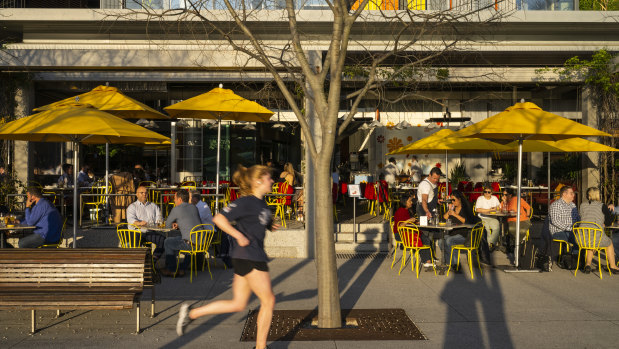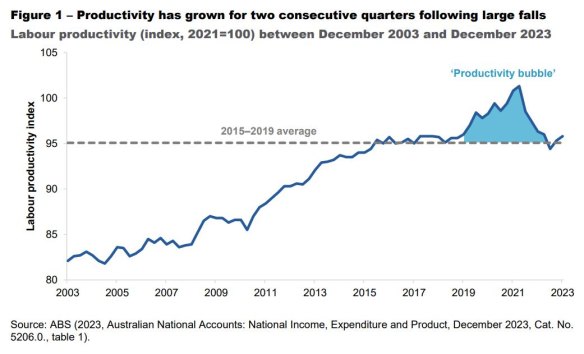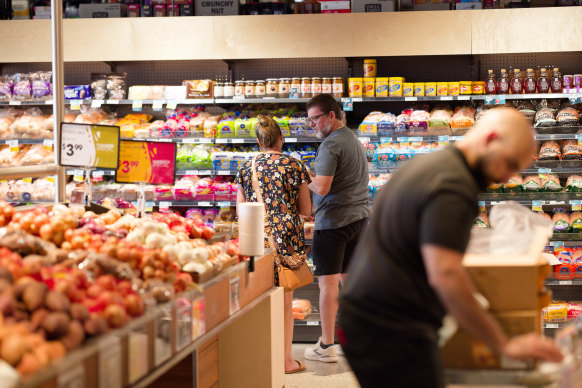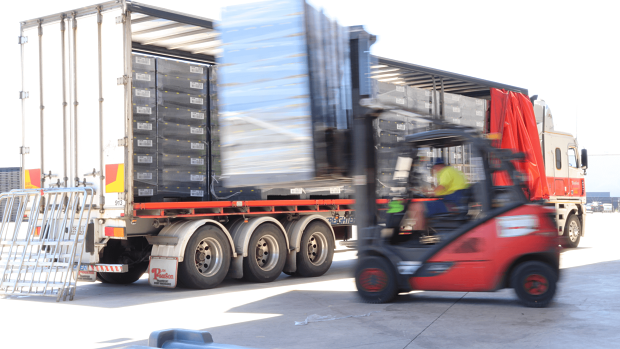This was published 7 months ago
Opinion
The pandemic pumped up productivity. Then the bubble burst
Millie Muroi
Economics WriterWhen COVID-19 erupted across the globe in 2020, we shifted where we spent our time: we watched more movies, baked, and spent more time sharing meals.
Notably, for the economy, many of us moved towards higher-productivity jobs.
However, the pandemic didn’t necessarily shift our career motivations. As the Productivity Commission’s deputy chair Alex Robson said in the most recent productivity bulletin, a lot of the job-switching was due to lockdowns and restrictions.
Restaurant workers and hotel staff, for example – who work in less productive sectors – found their places of work shut down, or drastically cut employees’ working hours, while mining and agriculture firms mostly trundled on.

Once COVID-19 lockdowns disappeared, customers poured back into restaurants, coffee shops and accommodation.Credit: Louie Douvis
That’s not to say waiters and front-desk hospitality staff are bad at their jobs, or less important.
When we talk about productivity in our daily lives, less can mean laziness. But labour productivity, in an economic sense, is simply a measure of how much of something (output) a worker produces for each hour they work – not necessarily a gauge of how lazy they are.

Productivity bubbleCredit: Productivity Commission, ABS
Hospitality and accommodation are lower-productivity sectors, largely because they are less capital intensive: most of the work is reliant on people power rather than machines, and there’s not much room for improvement. There’s only so many ways you can innovatively make a coffee.
Mining and information technology tend to be more productive. That’s because of the heavy amount of machinery, equipment and infrastructure in these sectors. These investments can lead to big innovations, such as automation, and help firms to produce things on a larger scale.
As workers temporarily shuffled into these higher productivity sectors, overall labour productivity spiked to an all-time high. Then, the bubble burst.
Once COVID-19 lockdowns disappeared and customers poured back into restaurants, coffee shops and accommodation, these less-productive sectors reeled workers back into their businesses to meet the fast-growing demand. That’s when overall labour productivity started to return to pre-pandemic levels.
With many households then able to spend their pandemic stimulus payments and savings on more things, spending ramped up. And so, too, did the hours people needed to work for businesses to keep up.
As unemployment plunged to record lows, businesses started hiring people with less experience and skills. That’s not a bad thing, but it meant overall productivity fell while those new hires learned the ropes.
Hiring more people also meant each person had less capital stock – things such as tools, equipment and machines – to work with. A cafe with one coffee machine, for example, might have had to share it between five baristas instead of three, making each barista slightly less productive, even if they were together producing more coffees.
The problem with stagnant or lower productivity is that wage growth can start to feed into inflation, and vice versa. It’s called the wage-price spiral because we can end up trapped in a seemingly endless cycle.
Workers might ask for higher wages to compensate for higher living costs, but if they’re not being more productive, it ends up costing the company more to make the same quantity of goods or services. So, the business might decide to increase its prices to maintain profitability, which then pushes up workers’ living costs. Then the process repeats.

Shoppers have had to reduce their purchases to deal with cost-of-living pressures.Credit: Trevor Collens
That is why the Reserve Bank of Australia is so fixated on productivity growth. If wages are increasing, and productivity is falling behind, it risks worsening the inflation we’ve been experiencing for the past couple of years: a problem the cental bank battles by raising interest rates.
Improving productivity is not about working harder. Arguably, cost of living pressures and higher interest rates have pushed more people into taking on an additional job, or working longer hours to maintain their living standards. However, that hasn’t improved productivity. In fact, longer hours have tended to correspond with weaker productivity.
Now that the rollercoaster of pandemic productivity has smoothed out, we need to focus on boosting productivity.
Why? Firstly, it’s in the maths. Productivity equals output for each hour worked, so working longer hours means we’re distributing whatever quantity we’ve produced across a greater number of hours. Unless our total output grows by the same proportion as our hours worked (or more), the productivity number spat out in calculations will be lower than if we had worked fewer hours.
Secondly, if you’ve made it this far into the article, you might be starting to feel a little less focused. Fair enough. In the same way, working longer hours can end up making people more tired, and therefore less able to do their job efficiently.
So, where are we now? Has productivity hit rock bottom?
The Reserve Bank says productivity growth has picked up in the past two quarters. The Productivity Commission’s Robson says we can be more confident that the “freefall” in labour productivity which began in June 2022 has bottomed. Our productivity is now tracking above where we were in 2019, before the COVID-19 bubble.
It is thanks to a few things that we’re seeing the return to “productivity normal”. First, workers have been working slightly shorter hours in the three months to December – about 15 minutes less for each worker, to be more exact. Since about June last year, the falling hours worked has increased the capital stock (remember: equipment like the coffee machine) for each worker.

Russia’s invasion of Ukraine and China’s large-scale lockdowns might still have lingering effects on global supply chains.Credit: Thinxtra
But why are we working fewer hours? For one thing, there’s less consumer demand. Cost of living pressures and higher interest rates have pushed down household spending, while rising wages have made it more expensive for firms to hire and keep their employees.
We also may have become better at doing things. Remember those inexperienced workers we hired straight out of the pandemic when business was booming? They’ve had time to learn, practise their skills, and catch up to their more experienced colleagues.
And while hospitality and certain other service industries might generally be less productive than some other industries, they contributed the most to improved productivity in the December quarter. They also happen to be the industries which saw the biggest drop in hours worked.
Now, we can’t get too excited. The final six months of 2023 saw improved productivity, but we’re only a touch more productive than we were before the pandemic. As Angelina Bruno, Jessica Dunphy and Fiona Georgiakakis explain in a Reserve Bank report on Australian productivity, there are a few main reasons for this.
The first is external shocks – such as Russia’s invasion of Ukraine and China’s large-scale lockdowns – might still have lingering effects on the global supply chains for industries, such as construction, which heavily rely on importing materials.
Second, business investment has been weak for a while, meaning companies are spending less on growing capital stock, which, as you know, weakens productivity growth. Third, business movements within the economy have slowed: less new businesses have been entering, and there’s been a weakening in competition. When this happens, there’s less opportunity for workers to move around to the most efficient firms.
So, what can we do? Now that the rollercoaster of pandemic productivity has smoothed out, we need to focus on boosting productivity. First, we must make sure the economy remains open to international trade and investment because they will increase competition and lead to greater knowledge sharing across borders. By making more materials available, it can drive down the cost of producing things.
We must also develop one of our most important assets: our brains. Improving our education system – both in terms of quality and accessibility – from primary school through to higher education is key to improving productivity.
Remember, it’s about working smarter, not harder.
Ross Gittins is on leave.
The Business Briefing newsletter delivers major stories, exclusive coverage and expert opinion. Sign up to get it every weekday morning.